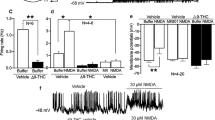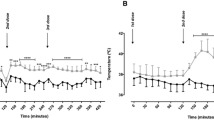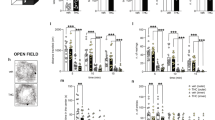Abstract
We have previously reported that a single injection of an ultra-low dose of delta-9-tetrahydrocannabinol (THC; the psychoactive ingredient of marijuana) protected the brain from pentylenentetrazole (PTZ)-induced cognitive deficits when applied 1–7 days before or 1–3 days after the insult. In the present study we expanded the protective profile of THC by showing that it protected mice from cognitive deficits that were induced by a variety of other neuronal insults, including pentobarbital-induced deep anesthesia, repeated treatment with 3,4 methylenedioxymethamphetamine (MDMA; “ecstasy”) and exposure to carbon monoxide. The protective effect of THC lasted for at least 7 weeks. The same ultra-low dose of THC (0.002 mg/kg, a dose that is 3–4 orders of magnitude lower than the doses that produce the known acute effects of the drug in mice) induced long-lasting (7 weeks) modifications of extracellular signal–regulated kinase (ERK) activity in the hippocampus, frontal cortex and cerebellum of the mice. The alterations in ERK activity paralleled changes in its activating enzyme MEK and its inactivating enzyme MKP-1. Furthermore, a single treatment with the low dose of THC elevated the level of pCREB (phosphorylated cAMP response element–binding protein) in the hippocampus and the level of BDNF (brain-derived neurotrophic factor) in the frontal cortex. These long-lasting effects indicate that a single treatment with an ultra-low dose of THC can modify brain plasticity and induce long-term behavioral and developmental effects in the brain.







Similar content being viewed by others
References
Abdullaev Y, Posner MI, Nunnally R, Dishion TJ (2010) Functional MRI evidence for inefficient attentional control in adolescent chronic cannabis abuse. Behav Brain Res 215:45–57
Agell N, Bachs O, Rocamora N, Villalonga P (2002) Modulation of the Ras/Raf/MEK/ERK pathway by Ca(2+), and calmodulin. Cell Signal 14:649–654
Amal H, Fridman-Rozevich L, Senn R, Strelnikov A, Gafni M, Keren O, Sarne Y (2010) Long-term consequences of a single treatment of mice with an ultra-low dose of Delta9-tetrahydrocannabinol (THC). Behav Brain Res 206:245–253
Assaf F, Fishbein M, Gafni M, Keren O, Sarne Y (2011) Pre- and post-conditioning treatment with an ultra-low dose of Delta9-tetrahydrocannabinol (THC) protects against pentylenetetrazole (PTZ)-induced cognitive damage. Behav Brain Res 220:194–201
Bambico FR, Nguyen NT, Katz N, Gobbi G (2010) Chronic exposure to cannabinoids during adolescence but not during adulthood impairs emotional behaviour and monoaminergic neurotransmission. Neurobiol Dis 37:641–655
Battisti RA, Roodenrys S, Johnstone SJ, Respondek C, Hermens DF, Solowij N (2010) Chronic use of cannabis and poor neural efficiency in verbal memory ability. Psychopharmacology (Berl) 209:319–330
Block RI (1996) Does heavy marijuana use impair human cognition and brain function? JAMA 275:560–561
Bovasso GB (2001) Cannabis abuse as a risk factor for depressive symptoms. Am J Psychiatry 158:2033–2037
Choi JS, Kim HY, Cha JH, Lee MY (2006) Ischemic preconditioning-induced activation of ERK1/2 in the rat hippocampus. Neurosci Lett 409:187–191
Clark RE, Broadbent NJ, Squire LR (2005) Hippocampus and remote spatial memory in rats. Hippocampus 15:260–272
Cohen M, Rasser PE, Peck G, Carr VJ, Ward PB, Thompson PM, Johnston P, Baker A, Schall U (2012) Cerebellar grey-matter deficits, cannabis use and first-episode schizophrenia in adolescents and young adults. Int J Neuropsychopharmacol 15:297–307
Coullaut-Valera R, Arbaiza-Diaz Del Rio I, de Arrue-Ruiloba R, Coullaut-Valera J, Bajo-Breton R (2011) Cognitive deterioration associated with the use of different psychoactive substances. Actas Esp Psiquiatr 39:168–173
Cunha C, Brambilla R, Thomas KL (2010) A simple role for BDNF in learning and memory? Front Mol Neurosci 3:1
Derkinderen P, Valjent E, Toutant M, Corvol JC, Enslen H, Ledent C, Trzaskos J, Caboche J, Girault JA (2003) Regulation of extracellular signal-regulated kinase by cannabinoids in hippocampus. J Neurosci 23:2371–2382
Ehrenreich H, Rinn T, Kunert HJ, Moeller MR, Poser W, Schilling L, Gigerenzer G, Hoehe MR (1999) Specific attentional dysfunction in adults following early start of cannabis use. Psychopharmacology (Berl) 142:295–301
Facchinetti F, Del Giudice E, Furegato S, Passarotto M, Leon A (2003) Cannabinoids ablate release of TNFalpha in rat microglial cells stimulated with lipopolysaccharide. Glia 41:161–168
Fasano S, Brambilla R (2011) Ras-ERK signaling in behavior: old questions and new perspectives. Front Behav Neurosci 5:79
Fehr KA, Kalant H, LeBlanc AE (1976) Residual learning deficit after heavy exposure to cannabis or alcohol in rats. Science 192:1249–1251
Fernandez-Ruiz J, Pazos MR, Garcia-Arencibia M, Sagredo O, Ramos JA (2008) Role of CB2 receptors in neuroprotective effects of cannabinoids. Mol Cell Endocrinol 286:S91–S96
Fried PA, Watkinson B, Gray R (2005) Neurocognitive consequences of marihuana—a comparison with pre-drug performance. Neurotoxicol Teratol 27:231–239
Gidday JM (2006) Cerebral preconditioning and ischaemic tolerance. Nat Rev Neurosci 7:437–448
Gowran A, Noonan J, Campbell VA (2011) The multiplicity of action of cannabinoids: implications for treating neurodegeneration. CNS Neurosci Ther 17:637–644
Grant I, Gonzalez R, Carey CL, Natarajan L, Wolfson T (2003) Non-acute (residual) neurocognitive effects of cannabis use: a meta-analytic study. J Int Neuropsychol Soc 9:679–689
Gruber SA, Rogowska J, Yurgelun-Todd DA (2009) Altered affective response in marijuana smokers: an FMRI study. Drug Alcohol Depend 105:139–153
Guzman M, Sanchez C, Galve-Roperh I (2001) Control of the cell survival/death decision by cannabinoids. J Mol Med (Berlin) 78:613–625
Guzman M, Sanchez C, Galve-Roperh I (2002) Cannabinoids and cell fate. Pharmacol Ther 95:175–184
Hausenloy DJ, Yellon DM (2006) Survival kinases in ischemic preconditioning and postconditioning. Cardiovasc Res 70:240–253
Hausenloy DJ, Yellon DM (2009) Preconditioning and postconditioning: underlying mechanisms and clinical application. Atherosclerosis 204:334–341
Hayakawa K, Mishima K, Nozako M, Hazekawa M, Ogata A, Fujioka M, Harada K, Mishima S, Orito K, Egashira N, Iwasaki K, Fujiwara M (2007) Delta9-tetrahydrocannabinol (Delta9-THC) prevents cerebral infarction via hypothalamic-independent hypothermia. Life Sci 80:1466–1471
Hillard CJ, Muthian S, Kearn CS (1999) Effects of CB(1) cannabinoid receptor activation on cerebellar granule cell nitric oxide synthase activity. FEBS Lett 459:277–281
Jager G, Kahn RS, Van Den Brink W, Van Ree JM, Ramsey NF (2006) Long-term effects of frequent cannabis use on working memory and attention: an fMRI study. Psychopharmacology (Berl) 185:358–368
** RL, Li WB, Li QJ, Zhang M, **an XH, Sun XC, Zhao HG, Qi J (2006) The role of extracellular signal-regulated kinases in the neuroprotection of limb ischemic preconditioning. Neurosci Res 55:65–73
Kanayama G, Rogowska J, Pope HG, Gruber SA, Yurgelun-Todd DA (2004) Spatial working memory in heavy cannabis users: a functional magnetic resonance imaging study. Psychopharmacology (Berl) 176:239–247
Karanian DA, Karim SL, Wood JT, Williams JS, Lin S, Makriyannis A, Bahr BA (2007) Endocannabinoid enhancement protects against kainic acid-induced seizures and associated brain damage. J Pharmacol Exp Ther 322:1059–1066
Kouri E, Pope HG Jr, Yurgelun-Todd D, Gruber S (1995) Attributes of heavy vs. occasional marijuana smokers in a college population. Biol Psychiatry 38:475–481
Landfield PW, Cadwallader LB, Vinsant S (1988) Quantitative changes in hippocampal structure following long-term exposure to delta 9-tetrahydrocannabinol: possible mediation by glucocorticoid systems. Brain Res 443:47–62
Lawston J, Borella A, Robinson JK, Whitaker-Azmitia PM (2000) Changes in hippocampal morphology following chronic treatment with the synthetic cannabinoid WIN 55,212-2. Brain Res 877:407–410
Lee HT, Chang YC, Wang LY, Wang ST, Huang CC, Ho CJ (2004) cAMP response element-binding protein activation in ligation preconditioning in neonatal brain. Ann Neurol 56:611–623
Lee TH, Yang JT, Ko YS, Kato H, Itoyama Y, Kogure K (2008) Influence of ischemic preconditioning on levels of nerve growth factor, brain-derived neurotrophic factor and their high-affinity receptors in hippocampus following forebrain ischemia. Brain Res 1187:1–11
Leker RR, Gai N, Mechoulam R, Ovadia H (2003) Drug-induced hypothermia reduces ischemic damage: effects of the cannabinoid HU-210. Stroke 34:2000–2006
Lin HY, Huang CC, Chang KF (2009a) Lipopolysaccharide preconditioning reduces neuroinflammation against hypoxic ischemia and provides long-term outcome of neuroprotection in neonatal rat. Pediatr Res 66:254–259
Lin WY, Chang YC, Lee HT, Huang CC (2009b) CREB activation in the rapid, intermediate, and delayed ischemic preconditioning against hypoxic-ischemia in neonatal rat. J Neurochem 108:847–859
Liou AK, Clark RS, Henshall DC, Yin XM, Chen J (2003) To die or not to die for neurons in ischemia, traumatic brain injury and epilepsy: a review on the stress-activated signaling pathways and apoptotic pathways. Prog Neurobiol 69:103–142
Lipsky RH, Marini AM (2007) Brain-derived neurotrophic factor in neuronal survival and behavior-related plasticity. Ann N Y Acad Sci 1122:130–143
Lundqvist T (2010) Imaging cognitive deficits in drug abuse. Curr Top Behav Neurosci 3:247–275
Mackie K, Hille B (1992) Cannabinoids inhibit N-type calcium channels in neuroblastoma-glioma cells. Proc Natl Acad Sci USA 89:3825–3829
Maddahi A, Edvinsson L (2011) Cerebral ischemia induces microvascular pro-inflammatory cytokine expression via the MEK/ERK pathway. J Neuroinflamm 7:14
Maresz K, Pryce G, Ponomarev ED, Marsicano G, Croxford JL, Shriver LP, Ledent C, Cheng X, Carrier EJ, Mann MK, Giovannoni G, Pertwee RG, Yamamura T, Buckley NE, Hillard CJ, Lutz B, Baker D, Dittel BN (2007) Direct suppression of CNS autoimmune inflammation via the cannabinoid receptor CB1 on neurons and CB2 on autoreactive T cells. Nat Med 13:492–497
Marsicano G, Goodenough S, Monory K, Hermann H, Eder M, Cannich A, Azad SC, Cascio MG, Gutierrez SO, van der Stelt M, Lopez-Rodriguez ML, Casanova E, Schutz G, Zieglgansberger W, Di Marzo V, Behl C, Lutz B (2003) CB1 cannabinoid receptors and on-demand defense against excitotoxicity. Science 302:84–88
Mauler F, Hinz V, Augstein KH, Fassbender M, Horvath E (2003) Neuroprotective and brain edema-reducing efficacy of the novel cannabinoid receptor agonist BAY 38-7271. Brain Res 989:99–111
McHale S, Hunt N (2008) Executive function deficits in short-term abstinent cannabis users. Hum Psychopharmacol 23:409–415
McMurtrey RJ, Zuo Z (2010) Isoflurane preconditioning and postconditioning in rat hippocampal neurons. Brain Res 1358:184–190
Mechoulam R, Panikashvili D, Shohami E (2002) Cannabinoids and brain injury: therapeutic implications. Trends Mol Med 8:58–61
Nagayama T, Sinor AD, Simon RP, Chen J, Graham SH, ** K, Greenberg DA (1999) Cannabinoids and neuroprotection in global and focal cerebral ischemia and in neuronal cultures. J Neurosci 19:2987–2995
Noshita N, Sugawara T, Hayashi T, Lewen A, Omar G, Chan PH (2002) Copper/zinc superoxide dismutase attenuates neuronal cell death by preventing extracellular signal-regulated kinase activation after transient focal cerebral ischemia in mice. J Neurosci 22:7923–7930
Okada M, Urae A, Mine K, Shoyama Y, Iwasaki K, Fujiwara M (1992) The facilitating and suppressing effects of delta 9-tetrahydrocannabinol on the rise in intrasynaptosomal Ca2+ concentration in rats. Neurosci Lett 140:55–58
O’Shea M, McGregor IS, Mallet PE (2006) Repeated cannabinoid exposure during perinatal, adolescent or early adult ages produces similar longlasting deficits in object recognition and reduced social interaction in rats. J Psychopharmacol 20:611–621
Panikashvili D, Simeonidou C, Ben-Shabat S, Hanus L, Breuer A, Mechoulam R, Shohami E (2001) An endogenous cannabinoid (2-AG) is neuroprotective after brain injury. Nature 413:527–531
Patton GC, Coffey C, Carlin JB, Degenhardt L, Lynskey M, Hall W (2002) Cannabis use and mental health in young people: cohort study. BMJ 325:1195–1198
Pignataro G, Scorziello A, Di Renzo G, Annunziato L (2009) Post-ischemic brain damage: effect of ischemic preconditioning and postconditioning and identification of potential candidates for stroke therapy. FEBS J 276:46–57
Reilly D, Didcott P, Swift W, Hall W (1998) Long-term cannabis use: characteristics of users in an Australian rural area. Addiction 93:837–846
Rostami F, Oryan S, Ahmadiani A, Dargahi L (2012) Morphine Preconditioning Protects Against LPS-Induced Neuroinflammation and Memory Deficit. J Mol Neurosci. doi:10.1007/sl1231-012-9726-4
Rubino T, Forlani G, Vigano D, Zippel R, Parolaro D (2004) Modulation of extracellular signal-regulated kinases cascade by chronic delta 9-tetrahydrocannabinol treatment. Mol Cell Neurosci 25:355–362
Rubino T, Vigano D, Realini N, Guidali C, Braida D, Capurro V, Castiglioni C, Cherubino F, Romualdi P, Candeletti S, Sala M, Parolaro D (2008) Chronic delta 9-tetrahydrocannabinol during adolescence provokes sex-dependent changes in the emotional profile in adult rats: behavioral and biochemical correlates. Neuropsychopharmacology 33:2760–2771
Rubino T, Realini N, Braida D, Guidi S, Capurro V, Vigano D, Guidali C, Pinter M, Sala M, Bartesaghi R, Parolaro D (2009) Changes in hippocampal morphology and neuroplasticity induced by adolescent THC treatment are associated with cognitive impairment in adulthood. Hippocampus 19:763–772
Rubovitch V, Gafni M, Sarne Y (2002) The cannabinoid agonist DALN positively modulates L-type voltage-dependent calcium-channels in N18TG2 neuroblastoma cells. Brain Res Mol Brain Res 101:93–102
Sagredo O, Pazos MR, Satta V, Ramos JA, Pertwee RG, Fernandez-Ruiz J (2011) Neuroprotective effects of phytocannabinoid-based medicines in experimental models of Huntington’s disease. J Neurosci Res 89:1509–1518
Sarne Y, Mechoulam R (2005) Cannabinoids: between neuroprotection and neurotoxicity. Curr Drug Targets CNS Neurol Disord 4:677–684
Sarne Y, Asaf F, Fishbein M, Gafni M, Keren O (2011) The dual neuroprotective-neurotoxic profile of cannabinoid drugs. Br J Pharmacol 163:1391–1401
Sato H, Bolli R, Rokosh GD, Bi Q, Dai S, Shirk G, Tang XL (2007) The cardioprotection of the late phase of ischemic preconditioning is enhanced by postconditioning via a COX-2-mediated mechanism in conscious rats. Am J Physiol Heart Circ Physiol 293:H2557–H2564
Sawe N, Steinberg G, Zhao H (2008) Dual roles of the MAPK/ERK1/2 cell signaling pathway after stroke. J Neurosci Res 86:1659–1669
Scallet AC (1991) Neurotoxicology of cannabis and THC: a review of chronic exposure studies in animals. Pharmacol Biochem Behav 40:671–676
Scallet AC, Uemura E, Andrews A, Ali SF, McMillan DE, Paule MG, Brown RM, Slikker W Jr (1987) Morphometric studies of the rat hippocampus following chronic delta-9-tetrahydrocannabinol (THC). Brain Res 436:193–198
Senn R, Keren O, Hefetz A, Sarne Y (2008) Long-term cognitive deficits induced by a single, extremely low dose of tetrahydrocannabinol (THC): behavioral, pharmacological and biochemical studies in mice. Pharmacol Biochem Behav 88:230–237
Shen M, Piser TM, Seybold VS, Thayer SA (1996) Cannabinoid receptor agonists inhibit glutamatergic synaptic transmission in rat hippocampal cultures. J Neurosci 16:4322–4334
Shouman B, Fontaine RH, Baud O, Schwendimann L, Keller M, Spedding M, Lelievre V, Gressens P (2006) Endocannabinoids potently protect the newborn brain against AMPA-kainate receptor-mediated excitotoxic damage. Br J Pharmacol 148:442–451
Solowij N, Michie PT, Fox AM (1995) Differential impairments of selective attention due to frequency and duration of cannabis use. Biol Psychiatry 37:731–739
Solowij N, Stephens RS, Roffman RA, Babor T, Kadden R, Miller M, Christiansen K, McRee B, Vendetti J (2002) Cognitive functioning of long-term heavy cannabis users seeking treatment. JAMA 287:1123–1131
Solowij N, Yucel M, Respondek C, Whittle S, Lindsay E, Pantelis C, Lubman DI (2011) Cerebellar white-matter changes in cannabis users with and without schizophrenia. Psychol Med 41:2349–2359
Stiglick A, Kalant H (1982a) Learning impairment in the radial-arm maze following prolonged cannabis treatment in rats. Psychopharmacology (Berl) 77:117–123
Stiglick A, Kalant H (1982b) Residual effects of prolonged cannabis administration on exploration and DRL performance in rats. Psychopharmacology (Berl) 77:124–128
Stiglick A, Kalant H (1983) Behavioral effects of prolonged administration of delta 9-tetrahydrocannabinol in the rat. Psychopharmacology (Berl) 80:325–330
Tourino C, Zimmer A, Valverde O (2010) THC Prevents MDMA Neurotoxicity in Mice. PLoS One 5:e9143
Troisi A, Pasini A, Saracco M, Spalletta G (1998) Psychiatric symptoms in male cannabis users not using other illicit drugs. Addiction 93:487–492
Truettner J, Busto R, Zhao W, Ginsberg MD, Perez-Pinzon MA (2002) Effect of ischemic preconditioning on the expression of putative neuroprotective genes in the rat brain. Brain Res Mol Brain Res 103:106–115
Tselnicker I, Keren O, Hefetz A, Pick CG, Sarne Y (2007) A single low dose of tetrahydrocannabinol induces long-term cognitive deficits. Neurosci Lett 411:108–111
van der Stelt M, Di Marzo V (2005) Cannabinoid receptors and their role in neuroprotection. Neuromolecular Med 7:37–50
van der Stelt M, Veldhuis WB, Bar PR, Veldink GA, Vliegenthart JF, Nicolay K (2001a) Neuroprotection by Delta9-tetrahydrocannabinol, the main active compound in marijuana, against ouabain-induced in vivo excitotoxicity. J Neurosci 21:6475–6479
van der Stelt M, Veldhuis WB, van Haaften GW, Fezza F, Bisogno T, Bar PR, Veldink GA, Vliegenthart JF, Di Marzo V, Nicolay K (2001b) Exogenous anandamide protects rat brain against acute neuronal injury in vivo. J Neurosci 21:8765–8771
Wada T, Kondoh T, Tamaki N (1999) Ischemic “cross” tolerance in hypoxic ischemia of immature rat brain. Brain Res 847:299–307
Wagner JA, Jarai Z, Batkai S, Kunos G (2001) Hemodynamic effects of cannabinoids: coronary and cerebral vasodilation mediated by cannabinoid CB(1) receptors. Eur J Pharmacol 423:203–210
Yin JC, Tully T (1996) CREB and the formation of long-term memory. Curr Opin Neurobiol 6:264–268
Zhang J, Chen C (2008) Endocannabinoid 2-arachidonoylglycerol protects neurons by limiting COX-2 elevation. J Biol Chem 283:22601–22611
Zhang M, Martin BR, Adler MW, Razdan RK, Jallo JI, Tuma RF (2007) Cannabinoid CB(2) receptor activation decreases cerebral infarction in a mouse focal ischemia/reperfusion model. J Cereb Blood Flow Metab 27:1387–1396
Acknowledgments
Tetrahydrocannabinol was kindly donated by Prof. R Mechoulam of The Hebrew University of Jerusalem, Israel, and by The National Institute on Drug Abuse (NIDA), USA. This study was supported by the Israel Anti Drug and Alcohol Authority.
Author information
Authors and Affiliations
Corresponding author
Rights and permissions
About this article
Cite this article
Fishbein, M., Gov, S., Assaf, F. et al. Long-term behavioral and biochemical effects of an ultra-low dose of Δ9-tetrahydrocannabinol (THC): neuroprotection and ERK signaling. Exp Brain Res 221, 437–448 (2012). https://doi.org/10.1007/s00221-012-3186-5
Received:
Accepted:
Published:
Issue Date:
DOI: https://doi.org/10.1007/s00221-012-3186-5




